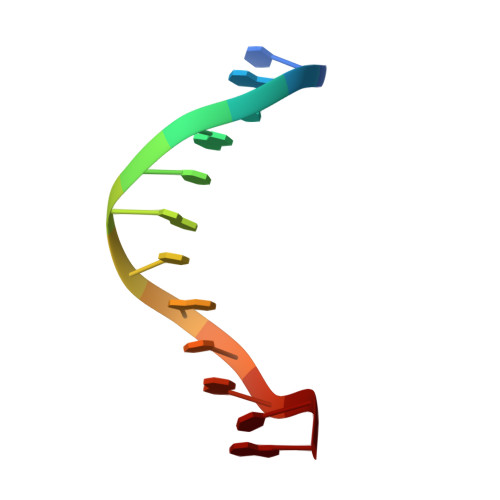Structure of an alternating-B DNA helix and its relationship to A-tract DNA.
Yoon, C., Prive, G.G., Goodsell, D.S., Dickerson, R.E.(1988) Proc Natl Acad Sci U S A 85: 6332-6336
- PubMed: 3413099
- DOI: https://doi.org/10.1073/pnas.85.17.6332
- Primary Citation of Related Structures:
1DN9 - PubMed Abstract:
The crystal structure of the synthetic DNA dodecamer CGCATATATGCG has been solved at 2.2-A resolution. Its central 6 base pairs adopt the alternating-B-DNA helix structure proposed nearly a decade ago. This alternating poly(AT) structure contrasts with the four known examples of what can be termed a poly(A) subfamily of B-DNA structures: CGCAAAAAAGCG, CGCAAATTTGCG, CGCGAATTCGCG, and CGCGAATTbrCGCG, their defining characteristic being a succession of two or more adenines along one strand, in a region of 4 or more A.T base pairs. All five helices show a characteristically narrow minor groove in their AT centers, but the mean propeller twist at A.T base pairs is lower in the alternating poly(AT) helix than in the poly(A) subfamily of helices. Three general principles emerge from x-ray analyses of B-DNA oligonucleotides: (i) GC and mixed-sequence B-DNA have a wide minor groove, whereas the minor groove is narrow in heteropolymer or homopolymer AT sequences. (ii) G.C base pairs have low propeller twist; A.T pairs can adopt a high propeller twist but need not do so. A high propeller twist can be stabilized by cross-strand hydrogen bonds in the major or minor groove, examples being the minor groove bonds seen in CCAAGATTGG and the major groove bonds that can accompany AA sequences in the poly(A) family. (iii) Homopolymer poly(A) tracts may be stiffer than are alternating AT or general-sequence DNA because of these cross-strand major groove hydrogen bonds. Poly(A) tracts appear internally unbent, but bends may occur at junctions with mixed-sequence DNA because of differences in propeller twist, base pair inclination, and base stacking on the two sides of the junction. Bending occurs most easily via base roll, favoring compression of the broad major groove.
- Molecular Biology Institute, University of California, Los Angeles 90024.
Organizational Affiliation:
















